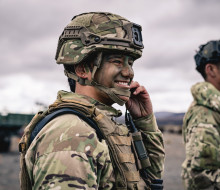
Keeping skills alive in transfer to Reserve Force
05 July 2024
Unfortunately you are viewing this website on an outdated browser which does not support the necessary features for us to provide an adequate experience. Please switch to a modern browser such as latest version of Google Chrome, Mozilla Firefox, Apple Safari or Microsoft Edge.
Ngā mihi nui
Air Commodore Andy Scott steps into the role of Air Component Commander, while Air Commodore D.J Hunt becomes Deputy Chief of Air Force.
Two Air Commodores are stepping into influential roles at a time when the Air Force is undergoing significant changes.
Air Commodore Andy Scott (photo right), appointed to Air Component Commander, comes to the job after studying for a year in London at Staff College.
He says it’s an exciting time for the Air Force with the arrival of the P-8A Poseidon and its roll-out into service, as well as looking at the arrival of the C-130J Hercules models.
“If we look at where we are going to be in three years, it’s looking like quite a different Air Force. We are looking at what is getting introduced and also at replacement options for the Seasprites and Boeing 757s - there are some huge changes and challenges ahead and making sure all the way through we’re still delivering on operations is really exciting.”
AIRCDRE Scott is also focussed on personnel and opportunities that are available across the Air Force that have opened up over the past year.
“For people who are adequately trained and can demonstrate their performance, they are going to start very quickly moving through the organisation and I think that’s really exciting. I look forward to being able to empower our people as they come through and see what we can do to ensure they are getting the working environment that they want to work in.”
Taking over the role from Air Commodore Shaun Sexton meant filling some big shoes, Air Commodore Scott said.
“I’d like to acknowledge that he’s done an incredible job with the changes and things that he has managed over his time as ACC. To see how far the air component has progressed under his watch is really impressive.”
Air Commodore D.J Hunt (photo left) says his latest role in Capability Branch has prepared him to look to the future facing the Air Force.
“I was leading planning for the investments or projects we’re going to start in the few years. I was working closely with the Ministry of Defence to give that forward look as to what investments we might be asking Government for and how that stacks up against priorities for the Service and Portfolios.”
He pointed to three areas to focus on during his time in the Deputy Chief of Air Force role.
The first was about representing the Chief of Air Force and the Air Force within Defence Force Headquarters, with other Air Forces, on the Air Force Museum of New Zealand board, and ensuring aligned messaging from an Air Force point of view.
“The second piece is about the Air Force of today – what I think of as the mechanics of running an Air Force. You’ve got training, you’ve got finance, and you’ve got people, all those things we’ve got to manage day-to-day to keep the Air Force ticking over,” AIRCDRE Hunt said.
The third area was focussed squarely on the future and beyond the next five years.
“We need to start aligning ourselves into what our Air Force will look like in 20 years, what it needs to be delivering, what the Government expects, what our partners expect from us and making sure we can deliver.
“And that’s exciting because the developments in technology – cyber, artificial intelligence, the information domain, the space domain – those are all relatively new for us and their use will become more prevalent in the future. We need to have an idea of how we are going to approach sequence them into Air Force operations.”
AIRCDRE Hunt said today’s Air Force was wildly different to when he was recruited – with archaic mobile phones, no internet, and information not as readily available as today.
“Now there are so many avenues that are going to open up for new aviators as the Air Force moves quickly in line with the digital information age. The new capabilities like the P-8A Poseidon and C-130J Hercules will see changes in the way we operate, but the emerging technologies will bring some real game changers and people shouldn’t constrain their thinking about how we use it.
“There are opportunities for aviators to adjust and develop their careers to suit and I think we are much more open to this than perhaps we were 20, 30 or 40 years ago. It’s exciting times.”